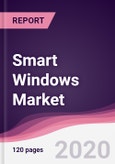Smart Windows can dynamically regulate light transmitting properties based on weather conditions and personal preferences, thus increasing the comfort of inhabitants and improving building energy efficiency by reducing the HVAC energy use, lighting loads, and glare. Smart windows are identified with several functionalities and competences, including innovative technologies that can drive growth in the market. Nanostructured materials offer new opportunities for next generation smart window technology. Nano materials can provide enhanced coloration efficiency, faster switching kinetics and longer lifetime. The Smart Windows Market is estimated to grow at a CAGR of 4.80% during the forecast period 2020–2025. Europe is the prominent region for the Smart Windows Market and is estimated to grow at a CAGR of 40.57% during the forecast period 2020–2025. The growth in Europe can be attributed to the governmental policies towards the use of energy efficient products and robust presence of significant industry players. The recent surge in energy costs has led to the growing demand for energy efficient products, hence improving the market penetration for smart windows.
Smart Windows Market Outlook
The Smart Windows Market has been fragmented into various segments in this report. On the basis of type, the market has been segmented into passive and active-on-demand. On the basis of the different applications wherein these smart windows are used, the market has been segmented into automotive, aerospace, commercial building, residential building and others. The commercial building sector is the major application area for the Smart Windows Market. The report also profiles the major market players taking into account their respective financial position, business strategies, product portfolio, and recent developments.
According to findings, active-on-demand types of smart windows will hold the largest market share during the forecast period. The segment is estimated to grow at a CAGR of 38.57% during the forecast period 2020–2025, and reach $1,680.74m by 2025
Smart Windows Market Growth Drivers
Electric cars are the vehicles of the future. These are environment-friendly vehicles and offer great mileage. The installation of smart glass windows in electric vehicles helps in maintaining the inner temperature of vehicles. With reduced A/C load, electric vehicles can extend their travel distance as well. From 2016 to 2020, the sales of EVs has increased by more than 57%. Also, solar panel sunroofs installed in these vehicles convert solar energy from the sun into electrical energy and send the electrical energy to a battery in the motor vehicle, which is an added advantage.
Smart Windows Market Challenges
The high production costs for smart windows act as a challenge for manufacturers in the market. Smart windows production cost is high on account of an increase in the raw material prices and rising energy costs. The cost of PDLC per sq. ft. is around $70, that of electrochromic is between $50 and $60, and that of SPD is approximately $100, whereas the cost of plate/flat window glass per sq. ft. is approximately between $25 and $100.
Some of the other challenges faced by smart window manufacturers include high competition, high bargaining power of consumers, lack of security of supply, threat from substitutes, trade barriers for Non-EU countries, and the counterfeiting of European designs.
Smart Windows Market Research Scope:
The base year of the study is 2020, with forecast done up to 2025. The study presents a thorough analysis of the competitive landscape, taking into account the market shares of the leading companies. These provide the key market participants with the necessary business intelligence and help them understand the future of the types of windows in the Smart Windows Market. The assessment includes the forecast, an overview of the competitive structure, the market shares of the competitors, as well as the market trends, market demands, market drivers, market challenges, and product analysis. The market drivers and restraints have been assessed to fathom their impact over the forecast period. This report further identifies the key opportunities for growth while also detailing the key challenges and possible threats. The key areas of focus include the types of smart windows, and their specific applications in the Smart Windows Market.
Smart Windows Market Report: Industry Coverage
- Types of Smart Windows: Passive and Active-on-Demand.
- Material Types in Smart Windows: Indium Tin Oxide, ITO Inks and Pastes, Transparent Organic Conductors and others.
- End Use Industries of Smart Windows: Architecture, Transportation, Marine and Others.
The Smart Windows Market report also analyzes the global region for the market.
The regions and countries covered in the study include:
- North America (U.S, Canada and Mexico)
- South America (Brazil, Venezuela, Argentina, Ecuador, Peru and others)
- Europe (U.K, Germany, France, Italy, Spain, Russia and others)
- Asia-Pacific (China, India, JAPNA, South Korea and others)
- Rest of World (Middle East and Africa)
Smart Windows Market Key Players Perspective:
Eastman Chemicals and AGC Inc. are the two major providers of smart window products globally. These two providers together accounted for approximately 25% share of the overall Smart Window Market in 2020. Eastman Chemicals, through its broad range of products, constant product launches, and innovation, has been successful in catering to a variety of customers.
Smart Windows Market Trends
The widespread adoption of Smart Windows in commercial office spaces is one of the market trends. The commercial office space sector is the leading adopter of smart windows because it can achieve significant cost savings, while enhancing the workplace productivity. It also offers access to outdoor views and natural daylighting. Due to these benefits, smart windows are being installed in a number of commercial office spaces.
Table of Contents
Methodology

LOADING...








